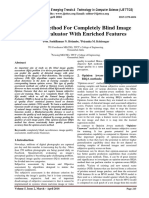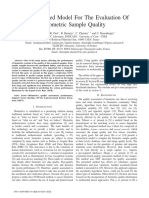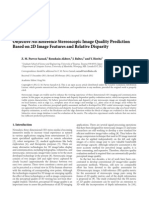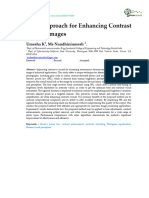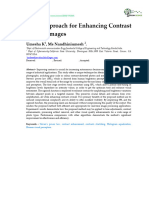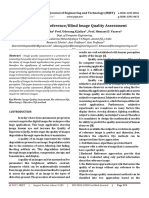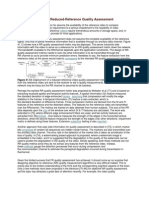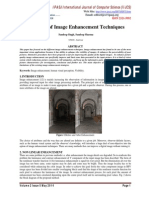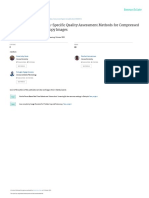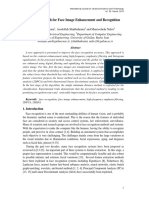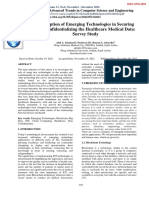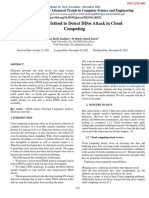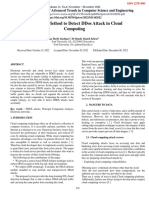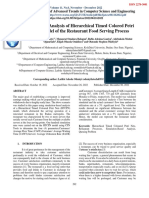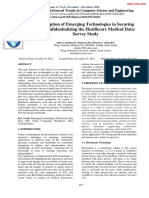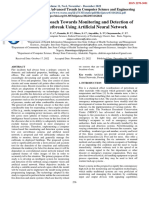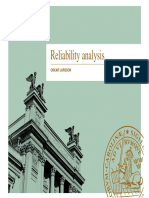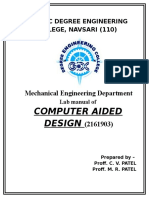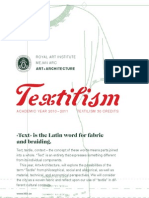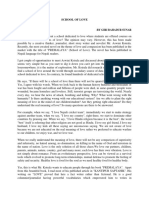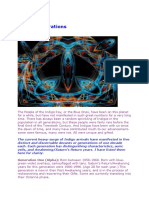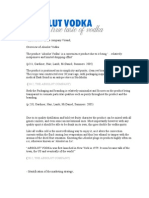Image Quality Assessment Based On Perceptual Blur Metric
Image Quality Assessment Based On Perceptual Blur Metric
Uploaded by
WARSE JournalsCopyright:
Available Formats
Image Quality Assessment Based On Perceptual Blur Metric
Image Quality Assessment Based On Perceptual Blur Metric
Uploaded by
WARSE JournalsOriginal Title
Copyright
Available Formats
Share this document
Did you find this document useful?
Is this content inappropriate?
Copyright:
Available Formats
Image Quality Assessment Based On Perceptual Blur Metric
Image Quality Assessment Based On Perceptual Blur Metric
Uploaded by
WARSE JournalsCopyright:
Available Formats
Emna CHEBBI et al.
, International Journal of Advanced Trends in Computer Science and Engineering, 1 (2), May June, 2012, 50 - 55
50
@ 2012, IJATCSE All Rights Reserved
Image Quality Assessment based on Perceptual Blur Metric
Emna Chebbi, Faouzi Benzarti, Hamid Amiri
Signal, Image Processing and Patterns Recognition (TSIRF) Laboratory
National Engineering School of Tunis (ENIT), Tunisia
emna.chebbi@gmail.com, benzartif@yahoo.fr, hamdilamiri@yhaoo.com
ABSTRACT
The recent development of digital image acquisition
technologies leads to better image quality, in terms of spatial
resolution and sensitivity. Image quality is a characteristic of
an image that measures the perceived image degradation.
Several techniques and metrics are proposed which can be
classified as Full-Reference (FR) method, No-Reference (NR)
method and Reduced Reference (RR) method. In this field of
image quality assessment, it is crucial to deep research the
physiology and psychology of human visual system. However,
it is obvious that strong correlation between the results and
human visual perception is essential. In this paper, we propose
a new approach for image quality assessment that combines
the perceptual blur metric and the index of Structural
Similarity (SSIM) in order to improve the image quality
quantification.
Keywords : Image Quality, Image Assessment, Human Visual
System, Structural Similarity, Blur perception
1. INTRODUCTION
Visual images are the most important and data intensive means
for humans to acquire information, digital image acquisition,
communication, storage processing, and display devices have
become ubiquitous in daily life. Since digital images are
subject to a wide variety of distortions in any of these, and
since image traffic has become quite dense, the assessment of
digital image quality has become an exceedingly important
topic. In fact, the lack of information caused by the processing
is results in an alteration of the original image, it is
necessary to evaluate the loss of image quality by
comparing the distorted image to the original one. The first
approach involves using human observers to assess image
quality. However, this method has several drawbacks. First,
it uses the subjectivity of human beings which assess
the image quality in different ways. In addition, it provides a
qualitative result, as we would like to have a quantitative
result. Finally, this subjective assessment is tedious and is
difficult to apply when the number of images to be treated is
important.
Therefore, objective methods for image quality assessment
have been proposed. These metrics should provide quality
scores consistent with human judgment which requires
the integration of the main properties of the Human Visual
System (HVS). The objective assessment of image quality or
video is based on many criteria for determining an objective
quality score. These criteria are classified into three categories
according to the information necessary for the assessment: Full
Reference (FR) [4][5], Reduced Reference (RR) [16][17] and
No Reference (NR) [2][13]. The FR methods require the
disposal of the reference image and the degraded version to
assess. These approaches are used in introducing degradation
systems, like systems of loss compression which aims to
estimate the amount of distortion caused by the compression
and quality of the resulting image. Generally, these
approaches are based on modeling the Human Visual System
(HVS) which they incorporate one or more properties of this
model. The RR methods provide a measure of quality with
only a small set of features measured on the
reference. However, the use of a limited amount of
information to develop a final quality score is much harder
than full reference methods. They are used in a transmission
where it is impossible to transmit all information related to
both versions of the image; the reduced reference is then
encoded and transmitted with the reference version to judge
the quality. The NR methods assess the quality of an image
without referring to the reference image. These methods were
the most difficult to develop since they are based on claims
that the image should be. These approaches are popular
because they do not require the transmission of the reference
version to evaluate the quality of the transmitted image.
This paper is organized as follows: In the next section, we
briefly review some related works in the image quality
assessment metrics. In section 3, we present the blur detection
using discrete wavelet transform. The proposed method is
presented in section 4. Experimental results are presented in
section 5. Finally conclusion is given is section 6.
ISSN No. 2278 -3091
Volume 1, No.2, May June 2012
International Journal of Advanced Trends in Computer Science and Engineering
Available Online at www.warse.org/ijatcse/info.html
Emna CHEBBI et al., International Journal of Advanced Trends in Computer Science and Engineering, 1 (2), May June, 2012, 50 - 55
51
@ 2012, IJATCSE All Rights Reserved
2. RELATED WORKS
In this section we briefly present some related works in the
image quality assessment metrics; which are divided into two
main classes as shown the Figure 1.
Figure 1: Image quality measures
The objective measure most commonly used is that of Index of
Structural Similarity (SSIM) [19]. This metric is an enhanced
version of UQI [18]. The index UQI is easy to implement and
can be applied to different types of images. It measures the
uncorrelation between the reference image and the distorted
image, as well as the degradation of the luminance component
and the contrast between the two versions of the image. This
criterion is then determined by the product of these three
measures for comparing the luminance l( x, y) , the contrast
c( x, y) and structure s( x, y) between two signals x and y.
l( x, y) =
2
x
2
+
2
, c( x, y) =
2c
x
c
j
c
x
2
+c
j
2
, (1)
s( x, y) =
co:
x
o
x
o
Where p
x
means the average of x, p
average of y, o
x
2
the
variance of x , o
2
variance of y and co:
x
the covariance
between x and y.
SSIM is obtained in case where p
x
2
+ p
2
or o
x
2
+ o
2
have
values close to zero. The formula is then given by:
SSIH( x, y) =
(2
x
j
+c
1
)(2co
xj
+c
2
)
(
x
2
+
j
2
+c
1
)(c
x
2
+c
j
2
+c
2
)
(2)
wherec
1
= ( k
1
I)
2
, c
2
= ( k
2
I)
2
, wit I refers to the dynamic
values of the pixels, or 255 for images coded on 8 bits, by
default k
1
= 0.01 and k
2
= 0.03 .
Among the most recent objective measures incorporating the
human visual system is the Visual Information Fidelity (VIF).
The VIF metric [9] is the result of an improvement in the
Information Fidelity Criterion [10] which is to integrate a
normalization step. This metric is obtained by the relation:
IIF =
I(C
N,]
;P
N,]
\ s
N,]
)
]
I(C
N,]
;L
N,]
\ s
N,]
)
]
(3)
where I(C
N,]
; F
N,]
\ s
N,]
) and I(C
N,]
; E
N,]
\ s
N,]
) refer to
the information extracted from the original image and its
degraded version from the sub-band j.
Other objective measure that integrates the SVH is that of
Visual Signal to Noise Rate (VSNR) [6]. The VSNR metric is
a quality measure based on analysis of wavelet coefficients; it
is divided into two steps. The first is to ensure that degradation
is well above the threshold of visibility before measuring. This
check is performed in each sub-band of wavelet
decomposition. The second step is to evaluate the perception
of degradation above the threshold of visibility.
VSNR is determined by:
ISNR = 10log[
C
2
( x)
P
2
(4)
Where C(x) denotes the average contrast of the reference
image and DP is the perceptual distortion. This metric does not
include color management or the spatial location of damage.
However, measurements of distances and structural
approaches are still consistent with the trial staff giving birth
metrics based on the integration of the properties of HVS.
Moreover, global quality measures have been defined recently
such as the Neural Fusion Approach [1]. Its is a new metric
with full reference based on the fusion of several conventional
metrics with full reference using the learning algorithm
artificial neural networks. The fusion brings performance more
important than using individual metrics. Indeed, the existing
metrics with full reference do not always produce excellent
results for all types of degradation. To confront this limitation,
it is appropriate to use a process of ranking and then use an
artificial neural network. It is to combine the best performing
metrics in a single metric called Index of Global Quality. The
image database used TID 2008 shows that this Index provides
assessment image quality results consistent with the subjective
assessment.
3. PERCEPTUAL BLUR DETECTION
A blur detection scheme is proposed using Haar wavelet
transform [11][14]. It may not only judge whether or not a
particular image is blurred but also to identify how the data
image is blurred which is based on edge sharpness
analysis. The proposed scheme benefits from the ability
of Haar wavelet transform in both discriminating various types
of edges and sharp recovery of the blurred version. In fact,
Wavelet transform is well known for its ability to analyze
multiple resolutions. Based on an important fact that the local
maxima of a wavelet transform to detect the localization of
irregular structures is proved [2][12].
Image qual i t y
assessment
Subj ect i ve
assessment
M ean Opi ni on Scor e
(M OS)
Just Not i ceabl e Di f f er ence
(JND),...
Obj ect i ve
assessment
Ful l Ref er ence
Di st ance measur es (M ES, PSNR, SNR, ...)
M et r i cs model i ng t he human vi sual
syst em (UQI, SSIM , M SSIM , VSNR, WSNR,
PSNR-HVS, IFC, VIF, ...)
Reduced
Ref er ence
Zi pf l aw
Car nec met r i c, ...
No Ref er ence
Bl i nd i mage qual i t y i ndex (BIQI)
Jpeg qual i t y scor e
Emna CHEBBI et al., International Journal of Advanced Trends in Computer Science and Engineering, 1 (2), May June, 2012, 50 - 55
52
@ 2012, IJATCSE All Rights Reserved
L L 3 H L 3 H L 2 H L 1: H or i zontal Detai l
(l evel 1)
L H 3 H H 3
L H 2 H H 2
L H 1: Ver ti cal Detai l
H H 1: Di agonal Detai l
(l evel 1)
Figure 2: Haar wavelet decomposition at level 3
The procedure to be followed to detect edge using Haar
wavelet transforms [8][15] starts by a Haar wavelet
decomposition level 3 of the distorted image (Figure 2).
Afterwards, it comes to build the edge map for each level by
the following formula:
E
mup
i
=
IE
2
+ EI
2
+ EE
2
; i = 1,2,3 (5)
The next stage consists in partitioning the edge maps and
determines the local maximum for each window. For the
highest level, the window size is 2x2. The low level is 4x4 and
the lowest is 8x8. Eventually, for each edge map, the edges
blurred must be determined. The Haar wavelet transform has
the benefit to recover the thin edges blurred which leads to
determine the number of edge blurred and so to extent the blur
amount. The Haar wavelet transform ducts to different rules
applied to detect the blur in the image presented. For each
edge point, for a given threshold, it is to identify both of edges
points which are more likely to be in the blurred image and
edge points that lost their intense.
In fact, if Emax
1
(k,l)>threshold or Emax
2
(k,l)>threshold or
Emax
3
(k,l)>threshold then (k,l) is an edge point where Emax
i
is the local maximum for the level i. For each edge point, it
comes to identify the type of edge. Most natural image
contains all types of edges: Dirac-structure, Roof-structure and
step-structure which is divided into Astep-structure and Gstep-
structure.
For each edge point (k,l):
if Emax
1
(k,l)>Emax
2
(k,l)>Emax
3
(k,l) then (k,l) is a
Dirac-structure or Gstep-structure,
if Emax
1
(k,l)<Emax
2
(k,l)<Emax
3
(k,l) then (k,l) is a
Roof-structure or Gstep-structure,
if Emax
2
(k,l)>Emax
1
(k,l) and Emax
2
(k,l)>Emax
3
(k,l)
then (k,l) is Roof-structure.
For each edge point (k,l) Gstep-structure or Roof-structure, if
Emax
1
(k,l)<threshold then (k,l) is more likely to be in a
blurred image.
Based on these Haar wavelet rules, an image is judged as
blurred if the ratio between Dirac-Structure and Roof-Structure
is superior of 0.05. Once there is presence of blur, it consists
then to determinate the blur amount existing in the distorted
image by calculating the ration between the numbers of edges
blurred Gstep-Structure and Roof-Structure.
4. PROPOSED APPROACH
The proposed method as shown in Figure 3, is to merge
the quality score obtained by the index of structural similarity
with the blur amount measured in order to obtain a quality
measure that takes account the perception of blur. The most
important assumption is that the human eye is typically
suitable for the extraction of structural information of an
image. It is then necessary to measure the degradation of
this structural information. The idea is to extract local
structural attributes of the image from which each block is
described by its brightness, contrast and structure.
We start the image quality assessment by using SSIM without
introducing the blur factor. The results provided by SSIM are
then compared to those delivered over the new metric
proposed. The purpose is to develop a tool to improve the
quantification of image quality. To achieve this aim, we
exploit the objective methods based on measuring perceptual
quality of an image. These methods consist in measuring the
error between a visibility degraded image and a reference
image using a variety of known properties of the visual system
Human (HVS). By exploiting the concept of HSV to which the
human visual is highly suitable for extract the structural
information of an image. We have exploited this concept in
quality assessment image. This is reflected in the measurement
of structural information as an index structural similarity
SSIM. However, SSIM doesnt take account of the blur
detection factor and to its extent [4].
Figure 3: Flow chart of the Proposed Approach
5. EXPERIMENTAL RESULTS
We choose for our experimental results the CSIQ database [7].
It consists of 30 original images; each is distorted using six
different types of distortions at four to five different levels of
Or i gi nal image Degr aded i mage
I mage qual i ty
assessment by
SSI M
I M
Bl ur amount
Scor e fusion
Fi nal
Assessment
Emna CHEBBI et al., International Journal of Advanced Trends in Computer Science and Engineering, 1 (2), May June, 2012, 50 - 55
53
@ 2012, IJATCSE All Rights Reserved
distortion. CSIQ images are subjectively rated base on a linear
displacement of the images across four calibrated LCD
monitors placed side by side with equal viewing distance to
the observer. Each original image in the database is distorted
using six different types of distortions at four to five different
levels of distortion. The distortions used in CSIQ are: JPEG
compression, JPEG-2000 compression, global contrast
decrements, additive pink Gaussian noise, and Gaussian
blurring the purpose of our research. In our experiments, we
used a few set original images presented by the Figure 4.
Figure 4: The original images of CSIQ data base
Figure 5: Blur images
The Figure 6 shows the mean of SSIM values versus blur
standard deviation of a set of blurred images (Figure 5).
For each blur image, it comes to determinate the score of
SSIM for a number of iteration well defined.
Figure 6: Mean of SSIM
The mean of SSIM values is represented by a decreasing curve
(Figure 6), a rise in the value of blur standard deviation
resulted in a decline in score of SSIM.
The fitted curve is a cubic polynomial:
ssim( x) = p1 x^ 3 + p2 x^ 2 + p3 x + p4 ( 6)
where the coefficient of the polynomial (with 95% confidence
bounds):
p
1
= 3.89c 005; p
2
= 0.001516 ; p
3
= 0.008339;
p
4
= 0 .8899.
According to results, SSIM is less sensitive to the change of
blur amount in an image. So, it becomes vital to determinate
the blur extent of an image. The Figure 7 presents the mean of
blur amount already calculated for all degraded images.
Figure 7: Mean of blur amount
The fitted curve of Blur amount is determined by the following
formula:
blur( x) = o1 sin( b1 x + c1 ) + o2 sin( b2 x +
c2) + o3 sin( b3 x + c3) ( 7)
Emna CHEBBI et al., International Journal of Advanced Trends in Computer Science and Engineering, 1 (2), May June, 2012, 50 - 55
54
@ 2012, IJATCSE All Rights Reserved
Where the coefficients are determined with 99% confidence
bounds:
o1 = 1.388 ; b1 = 0.129 ; c1 = 0.04447 ;
o2 = 0.7787; b2 = 0.2232 ; c2 = 2.307;
o3 = 0.1553; b3 = 0.3624; c3 = 3.842
It should then apply the proposed formula to get the final score
of a blur image:
SSI M_blur = SSIM_Score-(Blur Extent*) (8)
where =10. If BlurExtent=0, the image is judged unblurred
and the quality measure takes the value of SSIM score.
Figure 8: Mean of SSIM_blur
The proposed approach is presented by the figure below
(Figure 8); this is a downward curve. An increase in the value
of the blur standard deviation leads to a lower score of the
proposed quality measure. According to experiments, the
scores provided by the proposed approach are more declined
than SSIM; which reflects its effectiveness in assessing quality
of blurred images. The fitted curve of the proposed approach
is a cubic polynomial which is determined by the following
formula:
ssim
bIu
( x) = p1 x^ 3 + p2 x^ 2 + p3 x + p4 (9)
where the coefficients are determined with 99% confidence
bounds:
p1 = 5.048c 005 ; p2 = 0.001869;
p3 = 0.009232; p4 = 0 .8323
As it shown the results, the integration of the blur factor in
measuring the structural metric SSIM improves scores
obtained for the assessment measure of image quality and
provides satisfactory and relevant results that are consistent
with the human eye.
6. CONCLUSION
In this paper, a new approach for image quality assessment has
been proposed based on blur estimation. Experimental results
indicate that our metric significantly exceeds the performance
of the SSIM and provided results also correlate with the
human visual system. These results are encouraging as an
approach to conception of a metric of image quality taking into
account the perception of blur. They confirm the relevance
of the develop approach by incorporating a model to
aim psycho visual the aspect in this calculation.
REFERENCES
1. A.Chetouani, A.Beghadadi et and M.Deriche. A universal
full reference image quality metric based on a neural
fusion approach, Proceedings of 2010 IEEE 17
th
International Conference on Image Processing.
2. A. Ciancio, A.L.T da Costa, E.A.B da Silva, A. Said, R.
Smadani and P. Obrador. No-Reference Blur Assessment
of Digital Pictures Based on Multifeature Classifiers,
IEEE Transactions on Image Processing, Vol. 20, No. 1,
January 2011.
3. A. K. Moorthy and A. C. Bovik. A Modular Framework
for Constructing Blind Universal Quality Indices,
submitted to IEEE Signal Processing Letters, 2009.
4. C.Li et and A.C.Bovik. Content partioned structural
similarity index for image quality asssesment, Image
communication, 2010.
5. C.Yim and A.C.Bovik. Quality Assessement of
Deblocked Images, IEEE Transaction on Image
Processing, 2011.
6. D. Chandler and S. Hemami. Subjective image database,
http://foulard.ece.cornell.edu/dmc27/vsnr/vsnr.html,
2007.
7. E. C. Larson and D. M. Chandler. Most apparent
distortion: full-reference image quality assessment and
the role of strategy, Journal of Electronic Imaging, 19
(1), March 2010.
8. G. Cao, Y. Zhao and R. Ni. Edge-based Blur Metric for
Tamper Detection, Journal of In formation Hiding and
Mutimedia Signal Processing, Ubiquitous International,
Vol. 1, No. 1, 2010.
9. H.R. Sheikh and A.C Bovik. Image information and
visual quality, IEEE Transactions on Image Processing,
Vol. 15, pp. 430-444, 2006.
Emna CHEBBI et al., International Journal of Advanced Trends in Computer Science and Engineering, 1 (2), May June, 2012, 50 - 55
55
@ 2012, IJATCSE All Rights Reserved
10. H.R. Sheikh, A.C. Bovik and G. de Veciana. An
information fidelity criterion for image quality
assessment using natural scene statistics, IEEE
Transactions on Image Processing,Vol. 14, pp.2117-2128,
2005.
11. H. Tong, M. Li, H. Zhang and C. Zhang. Blur
Detection for Digital Images Using Wavelet
Transform, Multimedia and Expo, 2004, ICME '04.
2004 IEEE International Conference.
12. I. Makaremi and M. Ahmadi. Blur invariants : A novel
representation in the wavelet domain, Departement of
Electrical and Computer Engineering University of
Windsor, ON, Canada N9B 3P4, 2010.
13. L. Liang, S. Wang, J. Chen, S. Ma, D. Zhao et and
W. GAo. No-reference perceptual image quality metric
using gradient profiles for JPEG2000, Image
Communication, 2010.
14. R. Liu, Z. Li and J. Jia. Image Partial Blur Detection
and Classification, Computer Vision and Pattern
Recognition, 2008, CVPR 2008, IEEE Conference on
Hong Kong.
15. S. Wu, W. Lin, S. Xie, Z. Lu, E.P. Ong and S. Yao. Blind
blur assessment for vision-based applications, J. Vis.
Commun. Image R. 20 (2009) , pp.231-241.
16. U. Engelke, M. Kusuma, H-J. Zepernick and M. Caldera.
Reduced-reference metric design for objective
perceptual quality assessment in wireless imaging,
Signal processing: Image communication, 2009.
17. Y. Caron, P. Markis et and N. Vincent. Compressed
Image Quality Evaluation using Power Law Models,
IEEE 2006.
18. Z. Wang, A.C. Bovik, H.R. Sheikh and E.P. Simoncelli.
Image Quality Assessment: From Error Meaurement
to structural similarity, IEEE Transactions on Image
Processing, Vol. 13, January 2004.
19. Z. Wang, E.P. Simoncelli and A.C. Bovik. Multi-scale
structural similarity for image quality assessment,
Asilomar Conference on Signals, Systems and Computers.
You might also like
- Scaffold For Exposition - Letter To The EditorDocument1 pageScaffold For Exposition - Letter To The Editorgrace100% (1)
- Workshop Facilitation GuideDocument3 pagesWorkshop Facilitation Guideapi-325273054No ratings yet
- Dutchi Motors BV - DM2Document20 pagesDutchi Motors BV - DM2shimrozkhanNo ratings yet
- Plane and Solid GeometryDocument502 pagesPlane and Solid GeometryRyan Tegio100% (5)
- Image Quality PDFDocument8 pagesImage Quality PDFShaik BasheeraNo ratings yet
- Full-Reference Metric For Image Quality Assessment: Abstract-The Quality of Image Is Most Important Factor inDocument5 pagesFull-Reference Metric For Image Quality Assessment: Abstract-The Quality of Image Is Most Important Factor inIjarcsee JournalNo ratings yet
- Machine Learning To Design Full-Reference Image Quality Assessment AlgorithmDocument11 pagesMachine Learning To Design Full-Reference Image Quality Assessment AlgorithmCẩm Tú CầuNo ratings yet
- Statistical Evaluation of Image Quality Measures: İsmail AvcıbaşDocument40 pagesStatistical Evaluation of Image Quality Measures: İsmail AvcıbaşLenka KrulikovskáNo ratings yet
- A Robust Method For Completely Blind Image Quality Evaluator With Enriched FeaturesDocument5 pagesA Robust Method For Completely Blind Image Quality Evaluator With Enriched FeaturesInternational Journal of Application or Innovation in Engineering & ManagementNo ratings yet
- Fkqnet: A Biometric Sample Quality Estimation Network Using Transfer LearningDocument6 pagesFkqnet: A Biometric Sample Quality Estimation Network Using Transfer LearningsaraNo ratings yet
- No Reference Image Quality Assessment Based On DCT and SOM ClusteringDocument13 pagesNo Reference Image Quality Assessment Based On DCT and SOM ClusteringScarlet RedfoxNo ratings yet
- Quality PDFDocument18 pagesQuality PDFKamau GabrielNo ratings yet
- A New Image Quality Metric Using Compressive Sensing and A Filter Set Consisting of Derivative and Gabor FiltersDocument18 pagesA New Image Quality Metric Using Compressive Sensing and A Filter Set Consisting of Derivative and Gabor FiltersavcjournalNo ratings yet
- Applied Sciences: No-Reference Blurred Image Quality Assessment by Structural Similarity IndexDocument17 pagesApplied Sciences: No-Reference Blurred Image Quality Assessment by Structural Similarity IndexPhilip MorisNo ratings yet
- A Fuzzy & K-L Based Reduced Reference Imagequality: Bivaykumar, PankajraiDocument11 pagesA Fuzzy & K-L Based Reduced Reference Imagequality: Bivaykumar, PankajraiIOSRjournalNo ratings yet
- Image QualityDocument14 pagesImage QualitydocjagNo ratings yet
- An SVD-Based Gray-Scale Image Quality Measure For Local and Global AssessmentDocument8 pagesAn SVD-Based Gray-Scale Image Quality Measure For Local and Global AssessmentprashanthreddyburriNo ratings yet
- El Abed2011Document8 pagesEl Abed2011Kamel GhanemNo ratings yet
- Pankaj Pathak Not Found Research PaperDocument7 pagesPankaj Pathak Not Found Research PaperAnurag Singh BaghelNo ratings yet
- 153 CPBDDocument7 pages153 CPBDalisalahshor9No ratings yet
- Research ArticleDocument17 pagesResearch ArticleZachary Paul BrownNo ratings yet
- 2011 - IEEE - Image Quality Assessment by Separately Evaluating Detail Losses and Additive ImpairmentsDocument15 pages2011 - IEEE - Image Quality Assessment by Separately Evaluating Detail Losses and Additive Impairmentsarg.xuxuNo ratings yet
- Image Quality Assessment: From Error Visibility To Structural SimilarityDocument14 pagesImage Quality Assessment: From Error Visibility To Structural Similaritykyry.ix6624No ratings yet
- Journal DSM-camera Ready-Novel Approach Od Digital Images Contrast Enhansement-FinalDocument10 pagesJournal DSM-camera Ready-Novel Approach Od Digital Images Contrast Enhansement-FinalSunsets.nNo ratings yet
- An Evaluation Mechanism For Saliency Functions Used in Localized Image Fusion Quality MetricsDocument9 pagesAn Evaluation Mechanism For Saliency Functions Used in Localized Image Fusion Quality MetricsmukulmanoharNo ratings yet
- NIQEDocument13 pagesNIQEVij AyNo ratings yet
- Reduced Reference Image Quality Assessment Using Natural Image Statistics Model: Literature ReviewDocument4 pagesReduced Reference Image Quality Assessment Using Natural Image Statistics Model: Literature ReviewInternational Journal of Application or Innovation in Engineering & ManagementNo ratings yet
- No-Reference Perceptual Quality Assessment of Jpeg Compressed ImagesDocument4 pagesNo-Reference Perceptual Quality Assessment of Jpeg Compressed ImagesHoàng Mạnh QuangNo ratings yet
- Bid PaperDocument13 pagesBid PaperCoordinator Exams PUGKCNo ratings yet
- Journal Final DSM-novel Approach Od Digital Images Contrast EnhansementDocument10 pagesJournal Final DSM-novel Approach Od Digital Images Contrast EnhansementSunsets.nNo ratings yet
- Journal DSM-novel Approach Od Digital Images Contrast EnhansementDocument14 pagesJournal DSM-novel Approach Od Digital Images Contrast EnhansementSunsets.nNo ratings yet
- (Image Processing)Document13 pages(Image Processing)Sumant ShekharNo ratings yet
- 14-JICR-SP-MARCH-2020Document11 pages14-JICR-SP-MARCH-2020T JayasreeNo ratings yet
- Image PruningDocument69 pagesImage Pruningnarendran kNo ratings yet
- Streaming Video Quality Assessment in Digital TV Streams Under No-Reference ConditionsDocument16 pagesStreaming Video Quality Assessment in Digital TV Streams Under No-Reference ConditionsananthaNo ratings yet
- Applsci 12 06712 v2Document19 pagesApplsci 12 06712 v2haze.eslemNo ratings yet
- Image Quality Assessment From Error Visibility To Structural SimilarityDocument13 pagesImage Quality Assessment From Error Visibility To Structural Similarityonlineclass netNo ratings yet
- Ijcet: International Journal of Computer Engineering & Technology (Ijcet)Document10 pagesIjcet: International Journal of Computer Engineering & Technology (Ijcet)IAEME PublicationNo ratings yet
- To Study The Behavior of Concrete With The Replacement of Fine Aggregate by Quarry Dust Using Recycled Coarse AggregatesDocument5 pagesTo Study The Behavior of Concrete With The Replacement of Fine Aggregate by Quarry Dust Using Recycled Coarse AggregatesAnonymous CUPykm6DZNo ratings yet
- Electronics 10 02256Document20 pagesElectronics 10 02256Coordinator Exams PUGKCNo ratings yet
- Image Contrast Enhancement Using GA and PSO: A Survey: Ravindra Pal Singh, Manish Dixit Sanjay SilakariDocument4 pagesImage Contrast Enhancement Using GA and PSO: A Survey: Ravindra Pal Singh, Manish Dixit Sanjay Silakarianuj bhargavaNo ratings yet
- Image Fusion Metrics: Evolution in A NutshellDocument8 pagesImage Fusion Metrics: Evolution in A NutshellmukulmanoharNo ratings yet
- NR Va RRDocument2 pagesNR Va RRHoàng Mạnh QuangNo ratings yet
- Explainable Image Quality Assessments inDocument9 pagesExplainable Image Quality Assessments inKevin Ian Ruiz VargasNo ratings yet
- 8 X October 2020Document6 pages8 X October 2020IJRASETPublicationsNo ratings yet
- Iijcs 2014 05 06 011Document5 pagesIijcs 2014 05 06 011International Journal of Application or Innovation in Engineering & ManagementNo ratings yet
- Osteoporosis Detection Using Machine and Deep Learning TechniquesDocument15 pagesOsteoporosis Detection Using Machine and Deep Learning TechniquesSeddik KhamousNo ratings yet
- Quality Assessment For Online Iris ImagesDocument13 pagesQuality Assessment For Online Iris ImagesCS & ITNo ratings yet
- IQAWCEDocument8 pagesIQAWCEAbdulahi AbebeNo ratings yet
- Linear Model of Resolution and Quality of Digital ImagesDocument7 pagesLinear Model of Resolution and Quality of Digital Imagesgfernand34No ratings yet
- Object Detection in Enhanced Drone Imagery Using Extended ESRGAN With SSDDocument24 pagesObject Detection in Enhanced Drone Imagery Using Extended ESRGAN With SSDdarshanmythreya14No ratings yet
- Face Recognition Techniques: A Survey: V.VijayakumariDocument10 pagesFace Recognition Techniques: A Survey: V.Vijayakumaribebo_ha2008No ratings yet
- Novel Image Fusion Technique Based On DWT & MSVDDocument6 pagesNovel Image Fusion Technique Based On DWT & MSVDEditor IJRITCCNo ratings yet
- An Information Fidelity Criterion For Image Quality Assessment Using Natural Scene StatisticsDocument12 pagesAn Information Fidelity Criterion For Image Quality Assessment Using Natural Scene StatisticsNandkishore SinghNo ratings yet
- Significance of DimensionalityDocument16 pagesSignificance of DimensionalitysipijNo ratings yet
- Enhancing image quality using super-resolution residual network for small, blurry imagesDocument13 pagesEnhancing image quality using super-resolution residual network for small, blurry imagesIAES IJAINo ratings yet
- Evaluation of Image Fusion AlgorithmsDocument5 pagesEvaluation of Image Fusion AlgorithmsInternational Journal of Application or Innovation in Engineering & ManagementNo ratings yet
- Wavelet Based Face Recognition SystemDocument4 pagesWavelet Based Face Recognition SystemrednivsajNo ratings yet
- A New Approach For Face Image Enhancement and RecognitionDocument10 pagesA New Approach For Face Image Enhancement and RecognitionDinesh PudasainiNo ratings yet
- Assignmnet 2Document3 pagesAssignmnet 2api-263538737No ratings yet
- IWSSIMDocument14 pagesIWSSIMnabila brahimiNo ratings yet
- ELA ForgeryDocument5 pagesELA Forgerysuresh mpNo ratings yet
- I Jeter 0110122022Document6 pagesI Jeter 0110122022WARSE JournalsNo ratings yet
- I Ji Scs 011162022Document6 pagesI Ji Scs 011162022WARSE JournalsNo ratings yet
- On The Adoption of Emerging Technologies in Securing and Confidentializing The Healthcare Medical Data: Survey StudyDocument13 pagesOn The Adoption of Emerging Technologies in Securing and Confidentializing The Healthcare Medical Data: Survey StudyWARSE JournalsNo ratings yet
- I Jeter 0110122022Document6 pagesI Jeter 0110122022WARSE JournalsNo ratings yet
- A Prefatory Approach Towards Monitoring and Detection of Fire Outbreak Using Artificial Neural NetworkDocument5 pagesA Prefatory Approach Towards Monitoring and Detection of Fire Outbreak Using Artificial Neural NetworkWARSE JournalsNo ratings yet
- Automatic Change Detection On Satellite Images Using Principal Component Analysis, ISODATA and Fuzzy C-Means MethodsDocument8 pagesAutomatic Change Detection On Satellite Images Using Principal Component Analysis, ISODATA and Fuzzy C-Means MethodsWARSE JournalsNo ratings yet
- Simulation Based Analysis of Hierarchical Timed Colored Petri Nets Model of The Restaurant Food Serving ProcessDocument11 pagesSimulation Based Analysis of Hierarchical Timed Colored Petri Nets Model of The Restaurant Food Serving ProcessWARSE JournalsNo ratings yet
- GIS-technology of Water Drainage System (WDS) Modernization in Ukrainian City With Rugged TerrainDocument5 pagesGIS-technology of Water Drainage System (WDS) Modernization in Ukrainian City With Rugged TerrainWARSE JournalsNo ratings yet
- A Efficient Method To Detect Ddos Attack in Cloud ComputingDocument9 pagesA Efficient Method To Detect Ddos Attack in Cloud ComputingWARSE JournalsNo ratings yet
- A Efficient Method To Detect Ddos Attack in Cloud ComputingDocument9 pagesA Efficient Method To Detect Ddos Attack in Cloud ComputingWARSE JournalsNo ratings yet
- Optimal Placement and Sizing of Dgs in Distribution Networks Using Dandelion Optimization Algorithm: Case Study of An Algerian Distribution NetworkDocument9 pagesOptimal Placement and Sizing of Dgs in Distribution Networks Using Dandelion Optimization Algorithm: Case Study of An Algerian Distribution NetworkWARSE JournalsNo ratings yet
- Spoken Language Identification Using CNN With Log Mel Spectrogram Features in Indian ContextDocument7 pagesSpoken Language Identification Using CNN With Log Mel Spectrogram Features in Indian ContextWARSE JournalsNo ratings yet
- Spoken Language Identification Using CNN With Log Mel Spectrogram Features in Indian ContextDocument7 pagesSpoken Language Identification Using CNN With Log Mel Spectrogram Features in Indian ContextWARSE JournalsNo ratings yet
- Automatic Change Detection On Satellite Images Using Principal Component Analysis, ISODATA and Fuzzy C-Means MethodsDocument8 pagesAutomatic Change Detection On Satellite Images Using Principal Component Analysis, ISODATA and Fuzzy C-Means MethodsWARSE JournalsNo ratings yet
- A Efficient Method To Detect Ddos Attack in Cloud ComputingDocument9 pagesA Efficient Method To Detect Ddos Attack in Cloud ComputingWARSE JournalsNo ratings yet
- Simulation Based Analysis of Hierarchical Timed Colored Petri Nets Model of The Restaurant Food Serving ProcessDocument11 pagesSimulation Based Analysis of Hierarchical Timed Colored Petri Nets Model of The Restaurant Food Serving ProcessWARSE JournalsNo ratings yet
- Optimal Placement and Sizing of Dgs in Distribution Networks Using Dandelion Optimization Algorithm: Case Study of An Algerian Distribution NetworkDocument9 pagesOptimal Placement and Sizing of Dgs in Distribution Networks Using Dandelion Optimization Algorithm: Case Study of An Algerian Distribution NetworkWARSE JournalsNo ratings yet
- GIS-technology of Water Drainage System (WDS) Modernization in Ukrainian City With Rugged TerrainDocument5 pagesGIS-technology of Water Drainage System (WDS) Modernization in Ukrainian City With Rugged TerrainWARSE JournalsNo ratings yet
- Simulation Based Analysis of Hierarchical Timed Colored Petri Nets Model of The Restaurant Food Serving ProcessDocument11 pagesSimulation Based Analysis of Hierarchical Timed Colored Petri Nets Model of The Restaurant Food Serving ProcessWARSE JournalsNo ratings yet
- On The Adoption of Emerging Technologies in Securing and Confidentializing The Healthcare Medical Data: Survey StudyDocument13 pagesOn The Adoption of Emerging Technologies in Securing and Confidentializing The Healthcare Medical Data: Survey StudyWARSE JournalsNo ratings yet
- Automatic Change Detection On Satellite Images Using Principal Component Analysis, ISODATA and Fuzzy C-Means MethodsDocument8 pagesAutomatic Change Detection On Satellite Images Using Principal Component Analysis, ISODATA and Fuzzy C-Means MethodsWARSE JournalsNo ratings yet
- Optimal Placement and Sizing of DGs in Distribution Networks Using Dandelion Optimization Algorithm: Case Study of An Algerian Distribution NetworkDocument9 pagesOptimal Placement and Sizing of DGs in Distribution Networks Using Dandelion Optimization Algorithm: Case Study of An Algerian Distribution NetworkWARSE JournalsNo ratings yet
- A Efficient Method To Detect Ddos Attack in Cloud ComputingDocument9 pagesA Efficient Method To Detect Ddos Attack in Cloud ComputingWARSE JournalsNo ratings yet
- A Prefatory Approach Towards Monitoring and Detection of Fire Outbreak Using Artificial Neural NetworkDocument5 pagesA Prefatory Approach Towards Monitoring and Detection of Fire Outbreak Using Artificial Neural NetworkWARSE JournalsNo ratings yet
- A Efficient Method To Detect DDos Attack in Cloud ComputingDocument9 pagesA Efficient Method To Detect DDos Attack in Cloud ComputingWARSE JournalsNo ratings yet
- A Prefatory Approach Towards Monitoring and Detection of Fire Outbreak Using Artificial Neural NetworkDocument5 pagesA Prefatory Approach Towards Monitoring and Detection of Fire Outbreak Using Artificial Neural NetworkWARSE JournalsNo ratings yet
- I Jeter 049112021Document8 pagesI Jeter 049112021WARSE JournalsNo ratings yet
- A Efficient Method To Detect DDos Attack in Cloud ComputingDocument9 pagesA Efficient Method To Detect DDos Attack in Cloud ComputingWARSE JournalsNo ratings yet
- GIS-technology of Water Drainage System (WDS) Modernization in Ukrainian City With Rugged TerrainDocument5 pagesGIS-technology of Water Drainage System (WDS) Modernization in Ukrainian City With Rugged TerrainWARSE JournalsNo ratings yet
- On The Adoption of Emerging Technologies in Securing and Confidentializing The Healthcare Medical Data: Survey StudyDocument13 pagesOn The Adoption of Emerging Technologies in Securing and Confidentializing The Healthcare Medical Data: Survey StudyWARSE JournalsNo ratings yet
- Marketing Bizniz Newsletter For Web Site Nov 25Document2 pagesMarketing Bizniz Newsletter For Web Site Nov 25api-272018433No ratings yet
- Document 6Document3 pagesDocument 6Vince Lloyd RaborNo ratings yet
- Adorno - What Is The Negative DialecticDocument30 pagesAdorno - What Is The Negative DialecticElisaNo ratings yet
- Peer Teaching ObservationDocument4 pagesPeer Teaching ObservationharrindlNo ratings yet
- Bayan, Karapatan Et Al Vs ErmitaDocument2 pagesBayan, Karapatan Et Al Vs ErmitaManuel Joseph FrancoNo ratings yet
- National Human Rights Institutions: 1. Ipra 2Document6 pagesNational Human Rights Institutions: 1. Ipra 2Princess Janine SyNo ratings yet
- Reliability Analysis: Oskar LarssonDocument54 pagesReliability Analysis: Oskar LarssonYathrib EidNo ratings yet
- Grow Big Sense Full Evaluation ReportDocument41 pagesGrow Big Sense Full Evaluation ReportSallyFortNo ratings yet
- Theory of Mechanics and Mechanisms 4th EditionDocument9 pagesTheory of Mechanics and Mechanisms 4th EditionTimothy's SpaceshipNo ratings yet
- Cad Lab Manual-2016Document28 pagesCad Lab Manual-2016Dilip Patel100% (1)
- Digital Logic - Computer ArchitectureDocument41 pagesDigital Logic - Computer ArchitectureManvir Singh100% (1)
- Textilism: Text Is The Latin Word For Fabric and BraidingDocument4 pagesTextilism: Text Is The Latin Word For Fabric and BraidingtihcnasNo ratings yet
- Speech - Modal Verbs - Cielo Suarez GameroDocument4 pagesSpeech - Modal Verbs - Cielo Suarez GameroCielo Isabel Suarez GameroNo ratings yet
- Introduction To Ic Theory Bloomfield 1933 PDFDocument21 pagesIntroduction To Ic Theory Bloomfield 1933 PDFFaizal RisdiantoNo ratings yet
- Mrunal Reasoning - Calendar Related MCQS, How To Solve QuicklyDocument14 pagesMrunal Reasoning - Calendar Related MCQS, How To Solve QuicklyRituraj GautamNo ratings yet
- 21st Century Sci TechDocument90 pages21st Century Sci TechBryan GraczykNo ratings yet
- Introduction To Business Management Individual AssignmentDocument10 pagesIntroduction To Business Management Individual AssignmentDanielNo ratings yet
- School of LoveDocument3 pagesSchool of LovegolmalbhoNo ratings yet
- Indigo Generations: by Lorie A. JohnsonDocument8 pagesIndigo Generations: by Lorie A. Johnsonaave22100% (1)
- Critical Thinking in A Nutshell How To Become An Independent Thinker and Make Intelligent Decisions (Thinknetic (Thinknetic) )Document96 pagesCritical Thinking in A Nutshell How To Become An Independent Thinker and Make Intelligent Decisions (Thinknetic (Thinknetic) )baraaothmanNo ratings yet
- A Robot Wrote This Entire Article. Are You Scared Yet, Human - Artificial Intelligence (AI) - The GuardianDocument10 pagesA Robot Wrote This Entire Article. Are You Scared Yet, Human - Artificial Intelligence (AI) - The GuardianMac Norhen E. BornalesNo ratings yet
- Dystopian Lit Ubd Unit 4Document2 pagesDystopian Lit Ubd Unit 4api-408283709No ratings yet
- Assigned Reading - Ethical Thinking PDFDocument7 pagesAssigned Reading - Ethical Thinking PDFRazero4No ratings yet
- Myers Briggs Type Indicator (MBTI)Document7 pagesMyers Briggs Type Indicator (MBTI)Transcend VisionNo ratings yet
- Space and Subjectivity Latin American PDFDocument233 pagesSpace and Subjectivity Latin American PDFcodillosNo ratings yet
- Tim and Eric and Zach For Absolut Vodka Viral 2008 FinalDocument11 pagesTim and Eric and Zach For Absolut Vodka Viral 2008 FinalMitchell Todd100% (1)








